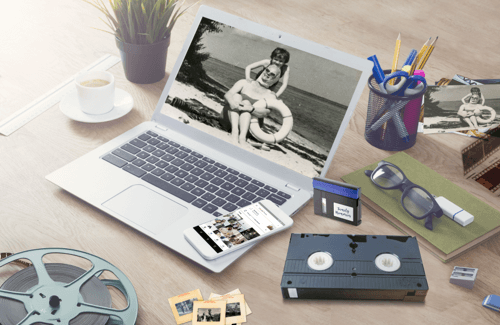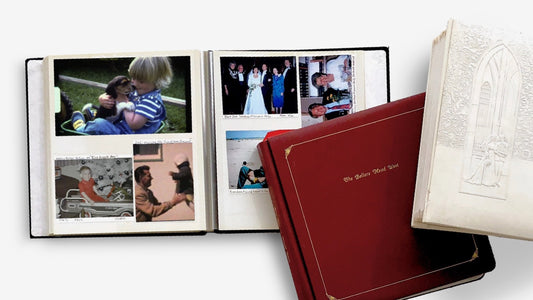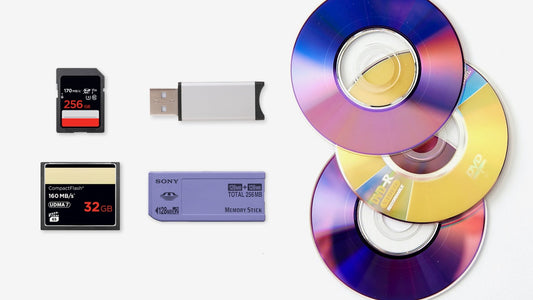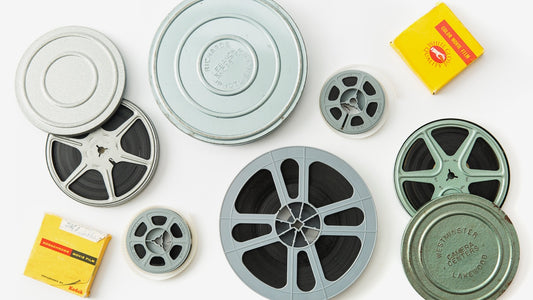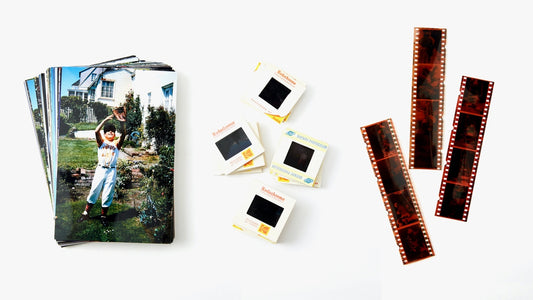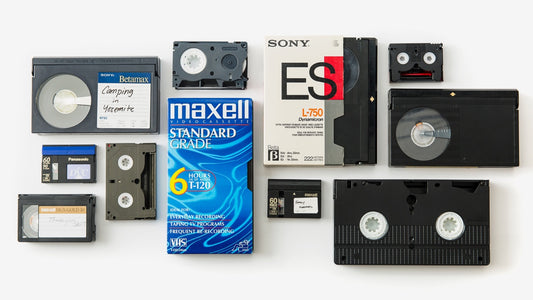Those precious family photos shouldn't be stuck in a dusty box. They deserve to be seen, shared, and protected. If you've ever worried about losing those irreplaceable prints to damage, or wished you could send a childhood snapshot to a relative in seconds, there's a simple solution. When you digitize photos, you create a secure, lasting archive of your family's history. This guide will walk you through your options, from DIY scanning to professional services. We'll also cover the benefits and costs, helping you bring your most cherished memories back to life for everyone to enjoy.
Key Takeaways
- Preserve your family history with digital photos: Convert physical photos to digital files to protect them from damage and make them easily shareable with loved ones. Digitization safeguards your memories and ensures they endure for generations.
- Find the best digitization method for you: Balance the size of your photo collection, your budget, and your long-term access needs to determine whether DIY scanning or a professional service like YesVideo is the right fit.
- Safeguard your digital memories: Protect your digitized photos by using both cloud storage and physical backups. This dual approach ensures your photos are safe, accessible, and ready to be enjoyed anytime, anywhere.
What is Photo Digitization?
Photo digitization is simply converting your physical photos—prints, negatives, or slides—into digital files. This lets you store, share, and enjoy your memories in a modern format. Think of it like taking a picture of a picture, but with much better quality and archiving potential. Instead of shoeboxes overflowing with fading prints, you'll have neatly organized digital albums you can access anytime, anywhere. Preserving your photo memories is easier than you think.
Digitizing photos isn't just about convenience; it's a crucial step in preserving your family history. Once your photos are digital, they're safe from the effects of time, like fading, discoloration, and physical damage. Plus, you won't have to worry about losing precious memories to disasters like fires or floods. The growing demand for photo digitization services shows just how important this process has become for families and individuals looking to protect their visual legacy. With digital files, you can ensure your memories are enjoyed for generations to come. This also makes it easier to share photos with family and friends, no matter where they are.
Why Digitize Your Photos?
Digitizing your photos is more than just creating digital copies; it's about safeguarding memories and making them easily accessible for generations to come. Think of it as preserving your family history in a format that's both safe and shareable. There are several key reasons why you should consider digitizing your photo collection.
Safeguard Your Family Memories
Photos capture precious moments, from family vacations and birthday celebrations to everyday snapshots that tell the story of our lives. Unfortunately, physical photos are vulnerable to damage and deterioration. Over time, they can fade, tear, or become discolored due to age, light exposure, or improper storage. Natural disasters, like fires or floods, can also destroy precious photo collections in an instant. Digitizing your photos creates a secure backup, protecting these irreplaceable memories from physical damage or loss. Once digitized, you can easily create multiple copies and store them in different locations, ensuring your memories are safeguarded for the future.
Share Your Photos with Anyone, Anywhere
Remember the days of bulky photo albums and slide projectors? Sharing photos used to require gathering everyone in the same room. With digital photos, sharing is effortless. You can easily email photos, post them on social media, or create online albums that family and friends can access from anywhere in the world. Digitization also makes it easier to organize and search your photos. No more sifting through boxes or albums—you can quickly find the photos you're looking for with a simple keyword search. Plus, you can use digital photos to create personalized gifts, slideshows, and other creative projects. The growing demand for photo digitization services speaks to how much people value easily sharing and accessing memories.
Protect Photos from Damage and Decay
Once your photos are digitized, they're no longer susceptible to the same risks as physical prints. Digital images won't fade, tear, or become discolored over time. Digitizing your photos also allows you to repair damaged photos. Scratches, tears, and other imperfections can often be digitally corrected, restoring your cherished photos to their former glory. Plus, you can enhance your digital photos by adjusting brightness, contrast, and color, making them look even better than the originals.
How to Digitize Photos at Home
Digitizing your photos at home can be a rewarding project. Here's a breakdown of common methods, from using a traditional scanner to leveraging the power of your smartphone.
Using a Flatbed Scanner for High-Quality Scans
A flatbed scanner, or a multifunction printer with scanning capabilities, offers excellent control over image quality. Place each photo face down on the scanner glass, ensuring it's aligned with the indicators. For crisp, clear digital images, scan at a resolution of at least 600 dpi. If you're aiming for archival-quality digitization, consider 1200 dpi. The TIFF file format preserves the most image data, ideal for long-term preservation, but creates larger files. JPEG is more common, offering smaller file sizes, but uses compression that can slightly reduce image quality.
Batch Scanning to Save Time
When you're facing a large collection of photos, batch scanning is a true game-changer. This method allows you to scan multiple photos at once on a flatbed scanner, which dramatically cuts down on the time you'd spend scanning each print individually. Once you have the initial scan, you can use simple software to crop each picture into its own file, making the process of digitizing a huge shoebox of memories feel much less daunting.
To get the best results, make sure your scanner is set to a resolution of at least 600 dpi, or even 1200 dpi if you want archival-quality images that capture every detail. Many modern scanners are built for this, and as photography site Shotkit points out, you can easily scan many photos at once and crop them later. This approach not only saves time but also helps you maintain consistent quality across your entire collection.
If the idea of scanning and cropping still sounds like too much work, don't worry. For those with extensive collections or limited time, a professional service is the perfect solution. When you send your photos to YesVideo, our technicians handle the entire digitization process by hand, ensuring each memory is treated with care. It’s a hands-off way to get high-quality digital files ready for you to share and enjoy.
Using Photo Scanning Apps on Your Smartphone
Photo scanning apps offer a convenient alternative to flatbed scanners, transforming your smartphone into a portable photo digitization tool. Apps like Google PhotoScan and Photomyne minimize glare and automatically crop and enhance images. While Photomyne is praised for its speed and ease of use, especially with batch scanning, experimenting with both apps can help you find what works best for your photos. For the best results, ensure your phone’s camera lens is clean and shoot in a well-lit area.
Other Helpful Scanning Apps
Beyond the big names, a few other apps are worth exploring, and some might already be on your phone. For instance, the built-in Notes app on an iPhone has a surprisingly effective document scanner that works well for photos. It automatically detects edges and corrects for perspective, giving you a clean, flat image. Another powerful tool is Microsoft Office Lens, which excels at capturing and straightening images, making it great for photos and documents alike. If you enjoy editing your photos after scanning, Adobe Photoshop Express offers robust tools to enhance your images right on your phone. The best app for you often comes down to personal preference, so feel free to experiment with a few to see which one fits your workflow.
Your Guide to Scanning with a Camera
If you have a DSLR camera or a newer smartphone with a high-quality camera, you can create digital copies yourself. Set up a copy stand or tripod to hold your camera steady and ensure consistent lighting. A neutral background, like white foam board, can help prevent color casts. Shoot in the highest resolution possible and save images as TIFF files for maximum quality. While this method requires more setup, it gives you complete control. For quick and easy digitization, photo scanning apps like Photomyne offer a convenient, portable solution, although a subscription might be required. Before scanning, gently clean your photos with a soft brush or compressed air to remove dust and debris.
Tips for Reducing Glare and Flattening Photos
Two common hurdles you might face are glare on glossy prints and the stubborn curl of older photos. To tackle glare, avoid using your camera’s built-in flash, which creates harsh hotspots. Instead, use indirect natural light from a window or place two lamps at a 45-degree angle to the photo for even lighting without reflections. Sometimes, all it takes is to slightly adjust your shooting angle to find a sweet spot where the glare disappears. For photos that won't lie flat, you can gently place them under a heavy book for a day or two before scanning. This simple trick helps prevent distorted edges and ensures a crisp, even capture of the entire image, making your digital copy look clean and professional.
Choosing the Right Scan Settings (DPI)
When you're scanning photos at home, the settings you choose make a huge difference. The most important setting is DPI, or dots per inch, which determines the resolution and clarity of your digital image. For standard photo prints you plan to share online or view on a screen, a resolution of 600 dpi is a great starting point. This will give you a crisp, clear image. If you're hoping to create large prints from your scans or want to preserve them for archival purposes, it's best to scan at a higher resolution, like 1200 dpi. This captures more detail, ensuring your memories look fantastic for years to come. Also, consider the file format. TIFF files are best for quality because they don't compress the image, but the files are very large. JPEGs are smaller and more common, but they lose a tiny bit of quality each time they're saved.
Consider Hiring Local Help
If the thought of sorting, cleaning, and scanning hundreds or thousands of photos feels overwhelming, you're not alone. Handing the project over to a professional service can be a huge relief and save you a ton of time. Many people find that the quality from a dedicated service is excellent, and the photos come back perfectly digitized and organized. Instead of spending weekends hunched over a scanner, you can trust experts to handle your precious memories with care. This is an especially great option if you have a mix of formats, like photo prints, slides, and negatives, which can be tricky to scan at home.
When looking for a service, you want a team you can trust with your one-of-a-kind memories. At YesVideo, we've spent over 20 years helping families preserve their history. Our team handles every single photo by hand right here in the USA, ensuring your collection is treated with the respect it deserves. We specialize in photo transfer and can also digitize film and videotapes, making it a one-stop shop for your entire media library. Choosing a professional service gives you peace of mind, knowing your photos are being digitized with top-tier equipment for the best possible quality.
Our Top Picks for Photo Digitization Services
If DIY isn’t your style, several companies specialize in digitizing photos. Here’s a rundown of some popular services:
YesVideo
YesVideo offers comprehensive photo, slide, and even home video digitization services. They handle various formats, making it a one-stop shop for all your media transfer needs. You can learn more about their video transfer services on their website. For film digitization, check out their film transfer page. They also offer photo and album scanning services, providing a complete solution for preserving your memories. YesVideo provides a user-friendly online platform for ordering and tracking projects, simplifying the entire process.
Legacybox
Legacybox is a popular choice for digitizing photos, slides, and negatives. They offer various kit sizes to accommodate different collection sizes, which you can explore on their photo scanning service page. Legacybox provides professional digitization and multiple delivery options, including thumb drives and cloud storage, giving you flexibility in receiving your digital memories.
ScanMyPhotos
ScanMyPhotos emphasizes high-quality scans and quick turnaround times. Their bulk scanning options make them a good option for large photo collections. Their straightforward pricing, detailed on their website, makes it easy to understand the costs involved.
ScanCafe
ScanCafe specializes in high-quality photo digitization, including scanning, restoration, and enhancement. They are known for competitive pricing and a focus on customer satisfaction. You can find more information about their services on the ScanCafe website.
Memories Renewed
Memories Renewed focuses on preserving family memories through various digitization services, including photo scanning, video transfer, and restoration. They emphasize quality and customer service, making them a good choice for those who value personalized attention. Learn more about their services on their website.
FotoBridge
FotoBridge is another great choice that specializes in turning your boxes of printed photos into organized digital files. They have a strong reputation for quality, earning the title of 'Best Photo Digitizer' from New York Magazine. Plus, they process all photos right here in the USA, so you can be sure your memories won't be sent overseas. Their service is straightforward—you simply choose a package based on how many photos you want to scan. You can explore packages for scanning anywhere from a few hundred to several thousand photos at a standard 300 DPI resolution. Every order includes digital finishing to enhance image quality, a disc with your files, and free, secure return shipping for your original prints, giving you a complete solution for preserving your photo collection.
What to Look For in a Digitization Service
When you’re digitizing photos, a few key features will determine how happy you are with the final result. Understanding these elements will help you make informed decisions, whether you’re digitizing photos yourself or hiring a professional service like YesVideo.
Understanding Resolution and Image Quality
Resolution is key for crisp, clear digital images. Think of resolution as the level of detail captured—the higher the resolution, the more detail you preserve. Experts recommend aiming for at least 600 dpi (dots per inch) when scanning photos. Ideally, shoot for 1200 dpi for the best possible quality. This higher resolution captures the nuances of your original photos, ensuring your digital versions are as vibrant and detailed as possible. Also, consider saving your images in TIFF format. While TIFF files are larger, they offer superior image quality compared to other formats like JPEG.
Choosing Your File Format and Storage
Once your photos are digital, you’ll need a safe and accessible place to keep them. A good strategy is to use both an external hard drive and a cloud storage service. This redundancy protects your precious memories from data loss—whether your computer crashes or your hard drive fails, you’ll have a backup. Many professional digitization services offer several delivery methods. You might receive your digital photos on a thumb drive, through cloud storage (often with a yearly subscription), or even on a set of DVDs.
JPG vs. PNG vs. TIFF: What's the Difference?
When you digitize your photos, you'll encounter different file types. Think of them as different containers for your images. TIFF is the gold standard for archival quality. It saves every single detail from the original photo, which is why professionals love it for preservation. The trade-off is that TIFF files are huge and take up a lot of storage space. On the other hand, JPG (or JPEG) is the most common format you'll see. It uses compression to create much smaller files, making them perfect for emailing or posting online. This compression can cause a tiny loss in quality, but for most everyday uses, it's unnoticeable. PNG is another option, often used for graphics, but for your precious photo collection, the choice usually comes down to TIFF for master copies and JPG for easy sharing. Understanding the right file format helps you decide how to best store and use your newly digitized memories.
Restoring Color and Fixing Damage
While some at-home scanning methods or basic digitization services might remove dust, they often don’t include color correction or repair for damaged photos. If your photos have faded colors, scratches, or tears, consider a professional photo restoration service. Professionals use specialized software and equipment to restore photos to their former glory, correcting colors and repairing damage for truly stunning digital copies. This extra level of care ensures your memories look their best.
Safety and Security of Your Memories
Handing over a box of irreplaceable photos can feel like a huge leap of faith. These aren't just pieces of paper; they're tangible links to your family's history and most cherished moments. It's completely normal to feel a little anxious about shipping them off. The good news is that professional digitization services understand the value of what you're entrusting them with. Choosing a reputable company means your memories will be handled with the care and respect they deserve, from the moment they leave your hands to the moment they're safely returned.
The Risk of Shipping Irreplaceable Photos
The thought of sending your only copies of precious photos through the mail can be nerve-wracking. What if the package gets lost or damaged? While this is a valid concern, it's helpful to frame it as a single, calculated risk that leads to permanent security. Once your photos are digitized, you can create endless copies and store them on the cloud, on hard drives, and with family members. This ensures that even if something were to happen to the originals later on, your memories are protected forever. Reputable services like YesVideo provide robust, trackable shipping options to give you peace of mind throughout the process.
How Companies Protect Your Photos
Leading digitization companies have built their reputations on trust and meticulous care. They know they're handling one-of-a-kind items and have processes in place to protect them. For example, at YesVideo, every order is processed by hand in the USA, ensuring your photos receive individual attention from trained technicians. Many customers of professional services are often delighted to find that their original photos, some over 75 years old, are returned in perfect condition along with their new digital copies. Reading customer reviews can provide great insight into how a company handles original materials, helping you choose a service you can trust with your most valuable memories.
Delivery Timelines and Add-On Services
Once you've chosen a service, you'll likely be eager to see the results. Turnaround times can vary significantly between companies, depending on the size of your order, the services you select, and the time of year. It's also worth exploring the unique features and add-ons that can enhance your final digital collection. From color correction to creating custom slideshows, these extras can transform a simple digitization project into a beautifully curated family archive that's ready to be shared and enjoyed.
Comparing Turnaround Times
Patience is a virtue, especially when it comes to preserving memories. Standard turnaround times for photo digitization can range from a few weeks to a couple of months. This timeline allows technicians to carefully scan, inspect, and process each photo. While waiting can be hard, remember that a trustworthy service is focused on quality, not just speed. Many companies provide order tracking so you can follow your photos' journey. If you're on a tight deadline for a special event like an anniversary or holiday, some services offer expedited processing for an additional fee, ensuring you get your memories back when you need them.
Unique Features and Add-Ons to Look For
Not all digitization services are created equal. Some offer basic scanning, while others provide a full suite of options to enhance your photos. Look for services that offer different resolution choices, like 300 DPI for sharing online or higher resolutions for printing. Many companies also offer color correction and minor restoration as part of their packages. Some, like YesVideo, are a one-stop shop, allowing you to digitize not just photos but also photo albums, film reels, and videotapes all in one order. This can be incredibly convenient if you have a mixed-media collection you want to preserve.
How Your Final Files Are Delivered
Getting your digital files back is the most exciting part of the process. But how you receive them matters for long-term access and control. Most services offer several delivery methods, including cloud storage, USB drives, or even DVDs. Understanding the pros and cons of each option will help you choose the best format for your needs. Your choice impacts how easily you can share, organize, and back up your newly digitized memories, so it's worth considering before you place your order. This ensures your photos are ready to be enjoyed for years to come.
Avoiding Proprietary Cloud Storage
While receiving your photos via a cloud link is convenient, be mindful of proprietary storage systems. Some services may require an ongoing subscription to access your files, and their platforms can sometimes make it difficult to download your photos with their original file names and data. For the most control, opt to receive your files on a physical USB drive or as a direct download link. This allows you to immediately save the files to your own computer and back them up to your preferred cloud service, like Google Drive or Dropbox, and an external hard drive. This gives you full ownership and flexibility, ensuring your memories are truly yours to manage.
DIY vs. Pro Service: A Cost Breakdown
So, you’ve decided to digitize those precious photo memories—fantastic! Now comes the big question: do it yourself or hire a pro? Both options have their pros and cons, and cost is often a major deciding factor. Let’s break down the expenses involved in each approach.
Calculating Your DIY Digitization Costs
If you’re a hands-on type and enjoy a good project, DIY digitization can be appealing. You’ll need a scanner, and the price range varies quite a bit. Basic flatbed scanners start around $50, which is perfect for occasional use. For a large collection or higher quality scans, you might consider a dedicated photo scanner. These can cost upwards of $500, so it's a bigger investment. This AARP guide offers helpful tips on digitizing photos yourself. Don't forget about photo editing software! This could be a one-time purchase or a subscription. Free options exist, but they might have limited features.
How Much Do Professional Services Cost?
Professional services like YesVideo photo transfer take the hassle out of digitizing. You simply send your photos, and they handle everything. Pricing usually depends on how many photos you need digitized. Services often offer tiered packages, starting with smaller options for a few hundred photos and scaling up to larger packages for extensive collections. Compare pricing and services from different providers to find what works best for you.
Typical Price Per Photo
When you opt for a professional service, the cost is typically calculated per photo. Generally, you can expect to pay between $0.30 and $0.71 for each image. The final price often depends on factors like the resolution you choose for the scan and the size of your original photos. Higher resolution scans capture more detail, making them ideal for enlargements or archival purposes, but they usually cost a bit more. It’s a good idea to compare the pricing structures of different services to see what’s included. Some may offer bulk discounts, while others might have a flat rate that covers basic color correction and dust removal, giving you a clear picture of the total investment upfront.
Understanding How "Items" Are Counted
When comparing services, you might notice some companies price their packages by the "item" rather than by the individual photo. This can be a little confusing, so it’s important to read the details. For some services, one "item" might equal a bundle of 25 photos. This is common for companies that sell pre-paid boxes where you fill them with various media types. While this can be convenient, it’s helpful to do the math to understand your per-photo cost. Other services, like YesVideo, offer more straightforward pricing by charging for each individual photo, slide, or negative you send in, which makes it easier to calculate the exact cost for your collection.
Look for Seasonal Deals
A great way to save money on photo digitization is to keep an eye out for seasonal promotions. Many companies offer significant discounts around major holidays like Mother's Day, Father's Day, and Christmas, as these are popular times for sentimental gifts. It’s not uncommon to find deals offering 40% or even 50% off regular prices. To stay in the loop, consider signing up for the email newsletters of the services you’re interested in or following them on social media. This is a simple step that can lead to substantial savings, especially if you have a large collection of photos to digitize. A little patience can make preserving your memories much more affordable.
Don't Forget These Hidden Costs
Whether you go DIY or professional, watch out for those sneaky extra costs. With the DIY route, factor in the cost of ink, photo storage (external hard drives or cloud storage), and the value of your time. Professional services sometimes have add-on fees for things like faster turnaround times, extra care for delicate photos, or advanced image restoration. Make sure you know exactly what’s included in the price before committing. Some services might charge extra for high-resolution scans or specific file formats, so reading the fine print can save you from unexpected expenses.
Shipping and Insurance Fees
Sending your one-of-a-kind family photos through the mail can feel nerve-wracking, and for good reason. That’s why it’s so important to understand the shipping and insurance fees before you choose a digitization service. Some companies offer a guarantee against loss during shipping, which can provide much-needed peace of mind for such a precious cargo. For example, you might find services that offer an added safety protection plan or a financial guarantee if your package gets lost in transit. This is a crucial detail to look for, as it shows the company takes the safety of your irreplaceable memories seriously and stands behind its process.
Beyond insurance, you'll want to clarify how shipping costs are handled. Some services might include a pre-paid shipping box in their package price, while others charge for shipping separately. This can lead to unexpected costs, so it’s always a good idea to read the fine print or ask customer service directly. At YesVideo, we know how precious your memories are, which is why we've designed our process to be as secure and transparent as possible, with every order processed by hand right here in the USA. Factoring in these shipping and insurance details ensures your photos are protected every step of the way.
How to Prepare Your Photos for Digitization
Before you start digitizing, whether you're doing it yourself or using a service like YesVideo's photo transfer, taking the time to prepare your photos will make the process smoother and more efficient. This means organizing your collection and ensuring your photos are clean and handled with care.
How to Sort Your Photo Collection
Start by gathering all the photos you want to digitize. This might seem obvious, but it's important to have everything in one place before you begin. Once you have your collection assembled, sort your photos in a way that makes sense for you. You could organize them chronologically, by event, or even by family member. Creating a system now will make it easier to find and enjoy your digital photos later. Plus, if you're using a professional digitization service, organizing beforehand can help streamline the process. Digitizing your photos is a great way to protect them from damage or loss due to disasters like fires or floods, and it also makes sharing with family and friends easier, as AARP points out.
A Guide to Safely Cleaning Your Photos
Dust and debris can negatively impact the quality of your digital images. Gently clean your photos with a soft brush or compressed air before scanning. Avoid using any harsh chemicals or abrasive materials, as these can damage your precious memories. When handling your photos, hold them by the edges to avoid getting fingerprints on the surface. If you're working with particularly fragile photos, consider wearing cotton gloves. For better edge detection during scanning, use a plain, preferably white, background and bright, soft, natural light to avoid glare. Position your phone or scanner directly above the photos for the best results. If you're digitizing a large number of photos, a high-speed scanner like the Epson FastFoto can be a great investment; it's known for its speed and auto-feeding capabilities.
Keeping Your Digital Photos Safe for Years to Come
After digitizing your photos, safeguarding these precious memories is crucial. Think of it like finally getting all your family photos into albums—you wouldn't want to leave those albums unprotected. A good strategy involves using both cloud storage and physical backups. This two-pronged approach ensures you can access your photos easily while also having a safety net in case of any technical mishaps.
Why You Need Cloud Storage
Cloud storage services, like Google Photos or services bundled with Amazon Prime and Apple One, offer a convenient way to store and organize your digital photos. These services not only provide safe storage but often come with helpful tools to manage your growing photo library. Think of it as having a digital photo album that you can access from anywhere, anytime. Plus, it’s a great way to share photos with family and friends near and far. Cloud storage offers peace of mind knowing your photos are backed up off-site, protecting them from physical damage or loss. For more tips on digitizing and storing your photos, check out this helpful article from AARP.
Choosing a Service for Sharing vs. Archiving
When choosing how to digitize your photos, consider your main goal: are you looking for a quick way to share memories online, or are you creating a permanent digital archive for future generations? Services built for sharing, like many smartphone apps, are convenient for posting to social media but may not offer the high resolution needed for long-term preservation. For a lasting family archive, you’ll want a service that prioritizes quality. Professional services like YesVideo’s photo transfer focus on creating high-resolution digital files that safeguard your memories from physical damage and decay. This approach gives you the best of both worlds—a secure, high-quality archive that you can easily share with anyone, anywhere, ensuring your memories endure for years to come.
The Case for Physical Backups
While the cloud offers convenience and accessibility, having physical backups adds another layer of security. External hard drives or network-attached storage (NAS) devices are excellent options for creating physical backups of your digital photos. Consider this your backup to the backup—an extra precaution to safeguard against data loss due to hardware failure, accidental deletion, or issues with your cloud storage provider. Storing your photos in multiple locations ensures redundancy, meaning you'll have copies in different places. This way, even in a worst-case scenario, your precious memories remain safe. Physical backups are like having a spare set of prints tucked away in a safe place—an extra layer of protection for your irreplaceable memories. This article from AARP offers further guidance on protecting your digitized photos.
How to Store Your Original Photos After Scanning
After all the work of digitizing your photos, you might be tempted to clear out the clutter and toss the originals. But I'd encourage you to hold onto them. Think of your physical prints as the ultimate backup—a tangible piece of your family history that can't be lost to a hard drive failure or a forgotten password. The best way to store them is to keep them in the same organized batches you created before scanning. Place them in archival-quality, acid-free boxes or albums to protect them from discoloration. Then, find a cool, dry, and dark place for them, like a closet in the main part of your house, rather than a damp basement or a hot attic. Properly storing your original photos ensures they remain safe for future generations to appreciate, just like their digital counterparts.
Photo Digitization Myths, Busted!
Let's clear up some common misconceptions about digitizing photos. Understanding these myths will help you make informed decisions about preserving your precious memories.
Myth: Smartphone Scans Are Just as Good
While snapping a quick picture of a photo with your phone seems easy, it won't give you archival-quality results. Smartphone cameras prioritize convenience over the high resolution and color accuracy needed for long-term preservation. They often struggle to capture fine details, and the lighting can be inconsistent. For truly preserving your photos, a dedicated scanner or professional photo digitization service is the best approach. Think of it this way: you wouldn't take a snapshot of a priceless painting for insurance purposes, would you? Your photos deserve the same care. The AARP offers helpful tips on digitizing photos and emphasizes the limitations of smartphone scans.
Myth: Your Photos Will Come Back Disorganized
Some people worry about their photos getting mixed up during the digitization process. Services like Legacybox clearly state they can't guarantee photos will be returned in their original order. This is often due to the logistics of handling large quantities of photos and the scanning process itself. If maintaining the exact order is crucial for you—say, for a historical album—discuss this upfront with any digitization service you consider. You might also want to number your photos lightly on the back before sending them.
Myth: All Scans Are Perfectly Cleaned
Many digitization services offer basic dust removal during scanning, but this isn't the same as full photo restoration. Don't expect heavily damaged or faded photos to magically look brand new. Legacybox clarifies that they offer minimal dust removal, not extensive restoration. If your photos need significant repairs, consider professional photo restoration services separately. This might involve fixing tears, removing scratches, or color correcting faded images. Think of digitization as preserving what you have, and restoration as improving it.
How to Choose the Best Way to Digitize Your Photos
So, you’ve decided to digitize your photos—fantastic! Now, how do you choose the best method for your needs? It boils down to balancing your photo collection, budget, and how you want to access those memories in the future.
First, Take Stock of Your Photo Collection
Take a look at what you have. How many photos are we talking about? A few dozen? Hundreds? Thousands? The size of your collection plays a big role in deciding how to move forward. A small collection might be manageable to scan at home, while a massive collection could benefit from a professional photo scanning service. Also, consider the condition of your photos. Are they delicate, faded, or damaged? Professional services often specialize in handling these types of photos with extra care and can even offer photo restoration.
Factor in Your Budget and Timeline
Digitizing photos takes time and can cost money, whether you do it yourself or hire a pro. DIY can be more budget-friendly upfront, but factor in the cost of a good scanner, software, and—most importantly—your time. If you have a large collection or limited time, a professional service might be worth the investment. Services like YesVideo handle everything for you, from shipping to scanning and returning your originals. Think about what’s more valuable to you: saving money or saving time.
Plan for Long-Term Access and Sharing
Once your photos are digital, how do you plan to access them? Do you want to easily share them online with family and friends? [Cloud storage services]like Google Photos or iCloud offer convenient online access and sharing capabilities. If you prefer to keep your photos offline, make sure you have a reliable external hard drive or other storage solution. Consider how you’ll organize your digital photos, too. Professional services often provide options for organizing your photos by date, event, or even adding tags and descriptions. Thinking about these long-term access needs will help you make the right choice for digitizing and enjoying your precious memories for years to come.
Related Articles
- How to Transfer Slides to Digital: DIY & Pro Guide – YesVideo
- Top 6 Photo Scanning Services to Preserve Your Memories – YesVideo
- Convert Photo Slides to Digital: DIY & Pro Guide – YesVideo
- Negative Photos 101: A Comprehensive Guide – YesVideo
- YesVideo's Photo Digitization - Digitize Old Slides, & More
Frequently Asked Questions
What’s the difference between scanning a photo and taking a picture of it?
While snapping a quick photo with your phone seems easier, it won't capture the same level of detail as a scanner. Scanners are designed to create high-resolution digital copies that accurately reproduce colors and details, which is essential for preserving your photos long term. Think of it like making a copy of an important document – a photo of the document won't be accepted as official, but a scanned copy will.
My photos are really old and damaged. Can they still be digitized?
Absolutely! Even faded or slightly damaged photos can be digitized. While the digitization process creates a digital copy of the photo's current state, many professional services offer restoration options to improve the image quality after scanning. They can often repair minor damage, adjust colors, and enhance faded photos, making them look much better.
What’s the best way to organize my digital photos after they’re scanned?
Organizing your digital photos is key to enjoying them later. Consider organizing them chronologically, by event (like birthdays or vacations), or by family member. Many photo management programs and cloud storage services allow you to tag photos with keywords, making them easy to search and find later. Think of it like creating a digital photo album – you want to arrange it in a way that makes sense to you.
I have thousands of photos. Is it really worth digitizing them all?
Digitizing a large collection can seem daunting, but it's a worthwhile investment in preserving your family history. Think of it as safeguarding your memories against loss or damage. You don't have to do it all at once. You can start with the most important photos or tackle the project in smaller batches. Many professional services offer bulk discounts, making it more affordable to digitize large collections.
What’s the best way to ensure my digital photos are safe?
The best way to protect your digital photos is to store them in multiple locations. Cloud storage is convenient for access and sharing, but it's also wise to have a physical backup, like an external hard drive. This way, even if something happens to your cloud storage account or your computer, you'll still have a copy of your precious memories. Think of it like having a spare key – you hope you never need it, but you're glad you have it just in case.





